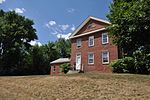Windsor Meadows State Park
1968 establishments in ConnecticutParks in Hartford County, ConnecticutProtected areas established in 1968State parks of ConnecticutUse mdy dates from August 2023 ... and 1 more
Windsor, Connecticut

Windsor Meadows State Park is a public recreation area on the west side of the Connecticut River in the town of Windsor, Connecticut. The state park occupies three largely undeveloped sections measuring 48, 19, and 88 acres (from north to south) located between railroad tracks and the river. Park activities include picnicking, fishing, boating, hiking, and biking.
Excerpt from the Wikipedia article Windsor Meadows State Park (License: CC BY-SA 3.0, Authors, Images).Windsor Meadows State Park
Woodland Park,
Geographical coordinates (GPS) Address Nearby Places Show on map
Geographical coordinates (GPS)
| Latitude | Longitude |
|---|---|
| N 41.818333333333 ° | E -72.645277777778 ° |
Address
Woodland Park 30
06095
United States
Open on Google Maps











